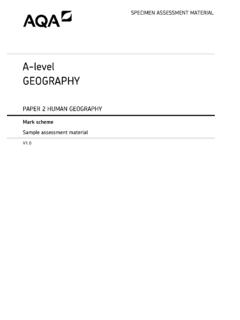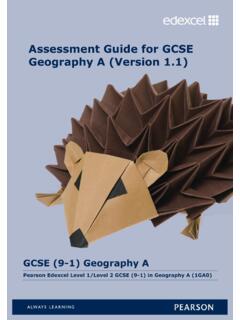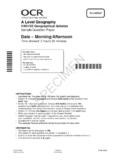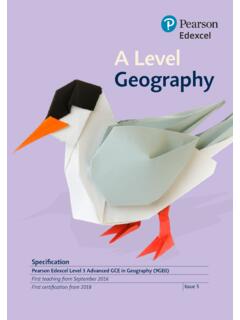Transcription of Get help and support GCSE GEOGRAPHY - AQA
1 GCSEGEOGRAPHY(8035)SpecificationFor teaching from September 2016 onwardsFor exams in 2018 onwardsVersion 16 February 2016 Copyright 2016 AQA and its licensors. All rights retains the copyright on all its publications, including the specifications. However, schools and colleges registered with AQA are permitted to copy material from this specification for their own internal Education (AQA) is a registered charity (number 1073334) and a company limited by guarantee registered in England and Wales (company number 3644723). Our registered address is AQA, Devas Street, Manchester M15 help and supportVisit our website for information, guidance, support and resources at can talk directly to the GEOGRAPHY subject teamE: 01483 477 791 3 GCSE GEOGRAPHY (8035). For exams 2018 onwards. Version for the most up-to-date specification , resources, support and administrationContents1 Introduction Why choose AQA for GCSE GEOGRAPHY support and resources to help you teach 52 specification at a glance Subject content Assessments 93 Subject content Living with the physical environment Challenges in the human environment Geographical applications Geographical skills 264 Scheme of assessment Aims and learning outcomes Assessment objectives Assessment weightings Spelling, Punctuation and Grammar (SPaG) 315 General administration Entries and codes Overlaps with other qualifications Awarding grades and reporting results Re-sits and shelf life Previous learning and prerequisites Access to assessment.
2 Diversity and inclusion Working with AQA for the first time Private candidates 344 Visit for the most up-to-date specification , resources, support and administrationAre you using the latest version of this specification ? You will always find the most up-to-date version of this specification on our website at We will write to you if there are significant changes to this GEOGRAPHY (8035). For exams 2018 onwards. Version for the most up-to-date specification , resources, support and administration1 Why choose AQA for GCSE GeographyOur specification enables a variety of teaching and learning approaches. This exciting and relevant course studies GEOGRAPHY in a balanced framework of physical and human themes and investigates the link between will travel the world from their classroom, exploring case studies in the United Kingdom (UK), higher income countries (HICs), newly emerging economies (NEEs) and lower income countries (LICs).
3 Topics of study include climate change, poverty, deprivation, global shifts in economic power and the challenge of sustainable resource use. Students are also encouraged to understand their role in society, by considering different viewpoints, values and created this specification with help from teachers and subject experts and we re confident you ll enjoy teaching it as much as your students will enjoy completion of this two year course, students will have the skills and experience to progress onto A-level and can find out about all our GEOGRAPHY qualifications at support and resources to help you teachWe ve worked with experienced teachers to provide you with a range of resources that will help you confidently plan, teach and prepare for resourcesVisit to see all our teaching resources. They include: dedicated student textbooks approved by AQA specimen question papers and mark schemes to show you what the exam will look like enhanced schemes of work to provide you with a range of suggestions for lesson activities, resources and more fieldwork toolkit to support your delivery of this key element of the specification training courses to help you deliver AQA GEOGRAPHY qualifications subject expertise courses for all teachers, from newly-qualified teachers who are just getting started to experienced teachers looking for fresh for examsVisit for everything you need to prepare for our exams, including: past papers, mark schemes and examiners reports specimen papers and mark schemes for new courses Exampro.
4 A searchable bank of past AQA exam questions exemplar student answers with examiner for the most up-to-date specification , resources, support and administrationAnalyse your students' results with Enhanced Results Analysis (ERA)Find out which questions were the most challenging, how the results compare to previous years and where your students need to improve. ERA, our free online results analysis tool, will help you see where to focus your teaching. Register at information about results, including maintaining standards over time, grade boundaries and our post-results services, visit your skills up-to-date with professional developmentWherever you are in your career, there s always something new to learn. As well as subject-specific training, we offer a range of courses to help boost your skills. Improve your teaching skills in areas including differentiation, teaching literacy and meeting Ofsted requirements.
5 Prepare for a new role with our leadership and management can attend a course at venues around the country, in your school or online whatever suits your needs and availability. Find out more at GEOGRAPHY (8035). For exams 2018 onwards. Version for the most up-to-date specification , resources, support and administrationGet help and supportVisit our website for information, guidance, support and resources at You can talk directly to the GEOGRAPHY subject teamE: 01483 477 7918 Visit for the most up-to-date specification , resources, support and administration2 specification at a glanceThis qualification is linear. Linear means that students will sit all their exams at the end of the Subject contentLiving with the physical Section A: The challenge of natural Section B: The living Section C: Physical landscapes in the UKChallenges in the human Section A: Urban issues and Section B: The changing economic Section C: The challenge of resource managementGeographical Section A: Issue Section B: FieldworkGeographical Geographical skills9 GCSE GEOGRAPHY (8035).
6 For exams 2018 onwards. Version for the most up-to-date specification , resources, support and AssessmentsPaper 1: Living with the physical environmentWhat's The challenge of natural hazards, The living world, Physical landscapes in the UK, Geographical skillsHow it's assessed Written exam: 1 hour 30 minutes 88 marks (including 3 marks for spelling, punctuation, grammar and specialist terminology (SPaG)) 35 % of GCSEQ uestions Section A: answer all questions (33 marks) Section B: answer all questions (25 marks) Section C: answer any two questions from questions 3, 4 and 5 (30 marks) question types: multiple-choice, short answer, levels of response, extended prose Paper 2: Challenges in the human environmentWhat's Urban issues and challenges, The changing economic world, The challenge of resource management, Geographical skillsHow it's assessed Written exam.
7 1 hour 30 minutes 88 marks (including 3 marks for SPaG) 35 % of GCSEQ uestions Section A: answer all questions (33 marks) Section B: answer all questions (30 marks) Section C: answer question 3 and one from questions 4, 5 or 6 (25 marks) question types: multiple-choice, short answer, levels of response, extended prose Paper 3: Geographical applicationsWhat's Issue evaluation, Fieldwork, Geographical skillsHow it's assessed Written exam: 1 hour 15 minutes 76 marks (including 6 marks for SPaG) 30 % of GCSE Pre-release resources booklet made available 12 weeks before Paper 3 examQuestions Section A: answer all questions (37 marks) Section B: answer all questions (39 marks) question types: multiple-choice, short answer, levels of response, extended prose++10 Visit for the most up-to-date specification , resources, support and administration3 Subject contentThe subject content is split into four units: Living with the physical environment, Challenges in the human environment, Geographical applications and Geographical units and the content is split into sections, with each section focusing on a particular geographical theme.
8 Unit sets out the requirements for fieldwork and issue evaluation. Unit sets out the geographical skills that students are required to develop and the specification content, students are required to study case studies and examples. Case studies are broader in context and require greater breadth and depth of knowledge and understanding. Examples are more focused on a specific event or situation, are smaller in scale and do not cover the same degree of Living with the physical environmentThis unit is concerned with the dynamic nature of physical processes and systems, and human interaction with them in a variety of places and at a range of aims of this unit are to develop an understanding of the tectonic, geomorphological, biological and meteorological processes and features in different environments, and the need for management strategies governed by sustainability and consideration of the direct and indirect effects of human interaction with the Earth and the Section A.
9 The challenge of natural hazardsIn this section, students are required to study all the Natural hazardsKey ideaSpecification contentNatural hazards pose major risks to people and of a natural of natural affecting hazard Tectonic hazardsKey ideaSpecification contentEarthquakes and volcanic eruptions are the result of physical tectonics distribution of earthquakes and volcanic eruptions and their relationship to plate processes taking place at different types of plate margin (constructive, destructive and conservative) that lead to earthquakes and volcanic GEOGRAPHY (8035). For exams 2018 onwards. Version for the most up-to-date specification , resources, support and administrationKey ideaSpecification contentThe effects of, and responses to, a tectonic hazard vary between areas of contrasting levels of and secondary effects of a tectonic and long-term responses to a tectonic named examples to show how the effects and responses to a tectonic hazard vary between two areas of contrasting levels of can reduce the effects of a tectonic why people continue to live in areas at risk from a tectonic monitoring, prediction, protection and planning can reduce the risks from a tectonic Weather hazardsKey ideaSpecification contentGlobal atmospheric circulation helps to determine patterns of weather and atmospheric circulation model.
10 Pressure belts and surface storms (hurricanes, cyclones, typhoons) develop as a result of particular physical distribution of tropical storms (hurricanes, cyclones, typhoons).An understanding of the relationship between tropical storms and general atmospheric of tropical storms and the sequence of their formation and structure and features of a tropical climate change might affect the distribution, frequency and intensity of tropical storms have significant effects on people and the and secondary effects of tropical and long-term responses to tropical a named example of a tropical storm to show its effects and monitoring, prediction, protection and planning can reduce the effects of tropical UK is affected by a number of weather overview of types of weather hazard experienced in the weather events in the UK have impacts on human example of a recent extreme weather event in the UK to illustrate.

















